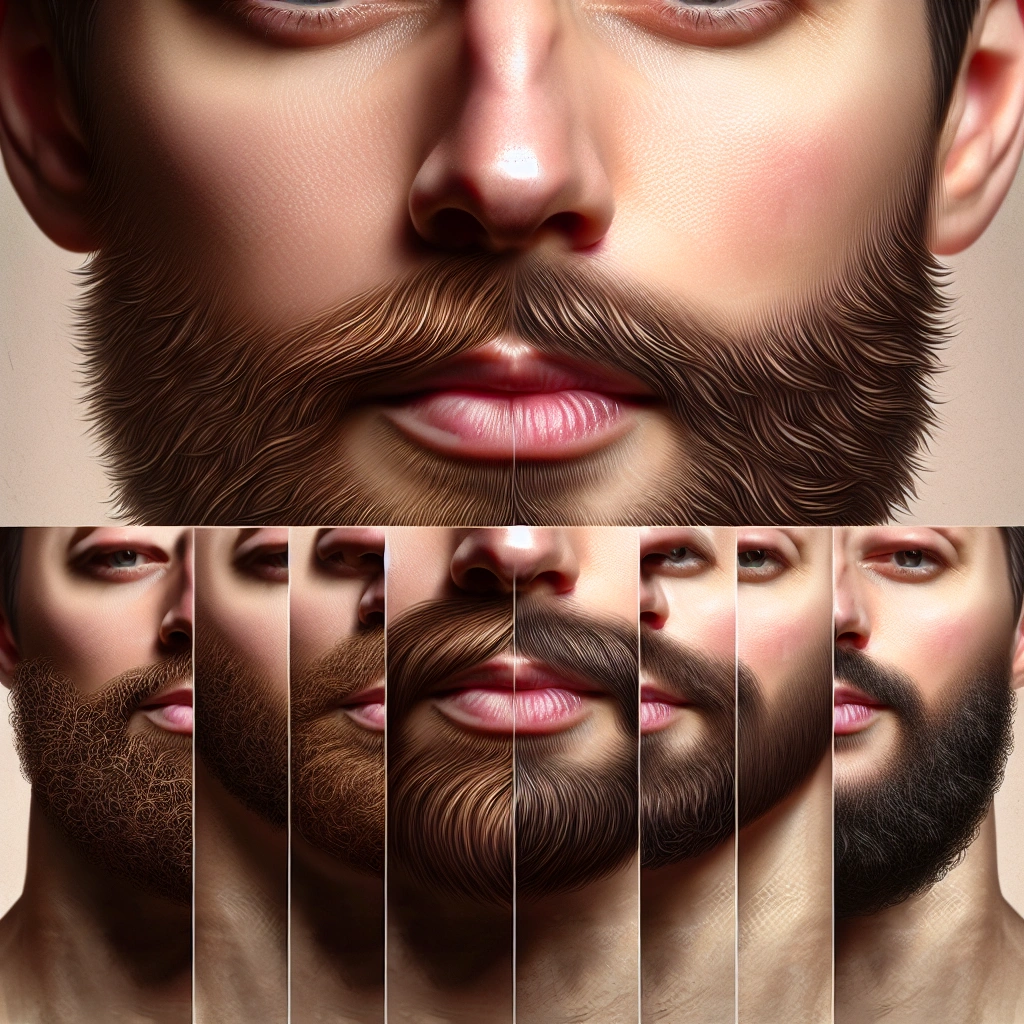Are you curious about beard terminal length? Understanding beard terminal length is essential for achieving your desired beard length.
In this article, we will explore the factors that influence beard terminal length and how to optimize growth.
Check out this Youtube video: Learn about the fascinating concept of beard terminal length and how it can impact your grooming routine and style!
Key Takeaways
-
Beard terminal length is determined by the length of the anagen phase, which varies based on genetic and hormonal factors.
-
Maintaining a healthy lifestyle through balanced diet, regular exercise, adequate sleep, and stress management can positively impact beard growth potential.
-
Genetics and testosterone levels play a significant role in determining individual terminal beard length.
-
Ethnicity influences beard growth, with different ethnic groups exhibiting distinct patterns of hair distribution on the face.
-
Diet rich in protein, vitamins, and minerals contributes to overall beard health and growth.
What Causes a Beard To Grow?
The Hair Life Cycle
The growth of a beard is influenced by the hair life cycle, which consists of various stages of hair growth and shedding. Understanding the hair life cycle can provide insights into the factors that contribute to beard growth and how to maximize it.
The hair life cycle comprises three main phases: anagen, catagen, and telogen. Each phase plays a crucial role in the overall growth and maintenance of the beard.
The Anagen Phase
The anagen phase is the most critical stage for beard growth. During this phase, the hair follicles in the beard region are actively growing and lengthening.
This phase can last for a few years, contributing significantly to the terminal length of the beard. Factors such as genetics, hormonal balance, and overall health can influence the duration of the anagen phase.
Nutrient-rich diets, proper hydration, and adequate sleep can help prolong the anagen phase, leading to enhanced beard growth.
In addition to external factors, internal health conditions, such as hormonal imbalances and stress, can impact the duration and effectiveness of the anagen phase. Therefore, maintaining a balanced lifestyle and seeking medical advice for any underlying health concerns can positively influence beard growth during the anagen phase.
The Catagen Phase
Following the anagen phase, the catagen phase marks a transitional stage in the beard’s growth cycle. During this phase, the hair follicles shrink and prepare for the next stage of the cycle.
While the catagen phase is relatively short compared to the anagen phase, it is essential for the regeneration and rejuvenation of the beard follicles. Proper beard care during the catagen phase, including regular grooming and nourishment, can support healthy follicle transition for subsequent growth.
The Telogen Phase
The telogen phase is the resting phase of the beard growth cycle. During this stage, beard hairs that have completed their life cycle are shed to make way for new growth.
It is vital to note that the duration of the telogen phase varies among individuals and may impact the overall density and volume of the beard. Providing adequate nutrition and using specialized beard care products can help minimize the negative effects of the telogen phase, promoting the healthy growth of new beard hairs.
Understanding the intricate process of the hair life cycle is crucial for comprehending what causes a beard to grow. By focusing on optimizing each phase of the cycle, individuals can achieve their desired beard terminal length and maintain healthy, vibrant facial hair.
Embracing a holistic approach to beard care, encompassing both internal and external factors, can lead to remarkable improvements in beard growth and quality.
| Stage | Duration | Key Characteristics |
|---|---|---|
| Anagen | 3-5 years | Active growth phase |
| Catagen | 10 days | Transitional phase |
| Telogen | 3-4 months | Resting and shedding phase |
Phases of Beard Growth
Anagen Phase
The anagen phase is the active growth phase of the beard hair follicles. During this phase, the hair follicles are actively growing, and the beard is getting longer and thicker. This phase can last for several years, and the duration varies based on genetic factors and individual characteristics.
During the anagen phase, the beard grows at an average rate of about 1/2 inch per month, but this can vary from person to person. Factors such as genetics, age, and overall health can influence the duration of the anagen phase and the rate of beard growth.
Catagen Phase
The catagen phase is a transitional phase where the beard follicles begin to shrink and detach from the blood supply. This phase marks the end of active growth, and the beard stops getting longer. The duration of the catagen phase is relatively short compared to the anagen phase, typically lasting for a few weeks.
Factors such as stress, hormonal changes, and certain medical conditions can influence the duration and intensity of the catagen phase, affecting the overall beard growth cycle.
Telogen Phase
The telogen phase is the resting phase of the beard growth cycle. During this phase, the beard follicles remain dormant, and no active growth occurs. This phase is crucial for the overall health and strength of the beard, as it allows the follicles to rejuvenate and prepare for the next growth cycle.
The telogen phase can last for several months, during which the old beard hair sheds, making way for new growth. It’s essential to provide proper care and nourishment to the beard during this phase to maintain its health and vitality.
“Terminal Length” and New Anagen Phase
The “terminal length” of a beard refers to the maximum length that a beard can reach during the anagen phase. This length is determined by genetic factors and varies from person to person. Some individuals may reach a significant terminal length, while others may have limitations based on their genetic predisposition.
Once the beard reaches its terminal length, it enters the new anagen phase, initiating a fresh cycle of growth. Proper grooming, maintenance, and a healthy lifestyle can optimize the potential terminal length of the beard and support ongoing growth cycles.
| Factors Influencing Beard Growth | Description |
|---|---|
| Genetics | Genetic predisposition plays a significant role in determining the terminal length of a beard. Individuals with strong genetic potential may have a longer terminal length. |
| Nutritional Support | A balanced diet rich in protein, vitamins, and minerals contributes to optimal beard growth potential and overall health. Essential nutrients such as vitamin B, biotin, and zinc support beard growth and quality. |
| Lifestyle Factors | Stress management, regular exercise, and adequate sleep positively impact beard health and growth cycles. Managing lifestyle factors can contribute to maximizing beard terminal length. |
Understanding the phases of beard growth, including the anagen, catagen, telogen phases, and the concept of “terminal length,” is pivotal for individuals aiming to cultivate and maintain a healthy and robust beard. By embracing proper grooming practices, nourishment, and lifestyle adjustments, individuals can optimize their beard growth potential and showcase their unique facial hair with confidence.
Maximum Beard Length
How long is MY terminal length?
Beard terminal length refers to the maximum potential length your beard can grow to. It is primarily determined by the length of the anagen phase, which is the active growth period of your facial hair.
This phase varies from person to person due to genetic and hormonal factors. Generally, the longer your anagen phase, the longer your maximum beard length will be.
Your genetic predisposition and testosterone levels play a significant role in determining your individual terminal length.
Can you make your terminal beard length longer?
While you can’t directly control the natural terminal length of your beard, certain factors may help optimize its growth potential. For instance, maintaining a healthy lifestyle, including a balanced diet and regular exercise, can positively impact hormone levels and overall well-being, potentially leading to improved beard growth.
Adequate sleep and stress management are also essential for hormonal balance, which may indirectly influence beard growth patterns. Additionally, keeping your facial skin and hair well-nourished through regular grooming and moisturization can promote healthy beard growth.
Factors Affecting Beard Growth and Length
Age
Beard growth is influenced by age due to changes in hormone levels. During puberty, as testosterone production increases, it leads to the development of facial hair. This continues to peak in the late 20s and early 30s, where many men experience their biggest beard growth. However, as men age and their testosterone levels decrease, beard growth may slow down.
Ethnicity
Ethnicity plays a significant role in determining beard growth. The number of hair follicles and their distribution on the face is influenced by genetics, with different ethnic groups exhibiting distinct patterns. For instance, men from East Asian backgrounds generally have fewer and sparser facial hair, attributed to genetic factors.
Time of Year
Beard growth rates have been observed to fluctuate with the changing seasons. Research indicates that beard growth rate is generally slowest during the winter and dramatically increases during the summer months, peaking in July. Therefore, the time of year can impact the rate and volume of facial hair growth.
Diet
Diet plays a crucial role in promoting healthy beard growth. Nutrient-dense foods rich in protein, vitamins, and minerals, such as lean meats, fish, fruits, and vegetables, contribute to overall hair health and growth. Adequate intake of essential nutrients like biotin, vitamin D, and omega-3 fatty acids supports the strength and quality of facial hair.
Breakage
Facial hair breakage can significantly impact beard length. Care practices such as excessive brushing, the use of harsh hair products, and exposure to environmental stressors can lead to hair breakage. Regular grooming, including the use of beard oil and gentle combing, helps prevent breakage and contributes to maintaining optimal beard length and quality.
| Age Group | Average Beard Growth (inches/month) |
|---|---|
| Teens | 0.2 – 0.3 |
| 20s – 30s | 0.5 – 0.6 |
| 40s and above | 0.3 – 0.4 |
Recommended Amazon Products for Beard Terminal Length
| Rogaine Men’s 5% Minoxidil Foam | Beard Growth Serum with Biotin & Caffeine | Beard Growth Multivitamin Gummies | Minoxidil Beard Growth Oil | Derma Roller Microneedle Kit for Beard Growth |
|---|---|---|---|---|
| ProsStimulates beard growthEasy to apply | ProsNatural ingredientsNourishes and strengthens the beard | ProsConvenient and enjoyable to takeSupports overall hair health | ProsPrecise applicationPromotes thick and full beard growth | ProsEnhances product absorptionPromotes overall skin health |
| ConsSome users report skin irritationResults may take several months to appear | ConsResults may vary for different usersScent may not be appealing to everyone | ConsNot as potent as topical treatmentsNot suitable for those with dietary restrictions | ConsRequires consistent use for best resultsMay cause temporary dryness | ConsRequires regular cleaning and maintenanceResults may be gradual |
Conclusion
Understanding beard terminal length is crucial in achieving your desired beard length. Factors such as genetics, hormonal balance, and overall health play a significant role in determining the terminal length of your beard.
By embracing proper grooming practices, nourishment, and lifestyle adjustments, individuals can optimize their beard growth potential and showcase their unique facial hair with confidence.
Maintaining a balanced diet rich in protein, vitamins, and minerals, as well as managing stress and getting adequate sleep, can positively impact beard health and growth cycles. Additionally, providing proper care and nourishment to the beard during the resting phase can support the healthy growth of new beard hairs, minimizing the negative effects of the telogen phase.
While you can’t directly control the natural terminal length of your beard, certain factors such as lifestyle adjustments and proper grooming practices may help optimize its growth potential. Your genetic predisposition and testosterone levels play a significant role in determining your individual terminal length.
By focusing on optimizing each phase of the beard growth cycle, individuals can maximize their beard terminal length and maintain healthy, vibrant facial hair.


